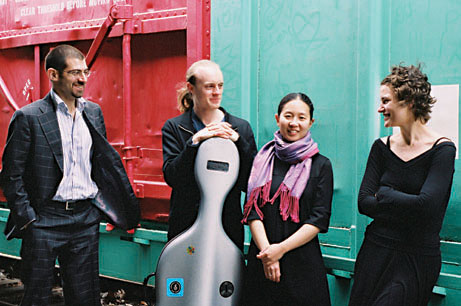Classical Music Review: Chiara String Quartet
By Caldwell Titcomb
Four youngish players, trained at the Juilliard School of Music, constituted themselves as the Chiara String Quartet. For several years they have held artist residency at the University of Nebraska-Lincoln. They have received a number of awards and prizes, and this season they are the Blodgett Artists-in-Residence at Harvard University, where they gave their first concert on October 30.

The Chiara String Quartet
The foursome – Rebecca Fischer and Julie Yoon, violins; Jonah Sirota, viola; and Gregory Beaver, cello – make a habit of including modern music on every program, and indeed have commissioned new pieces. This time they offered four works only one of which is in the standard repertory – and even this does not crop up all that frequently.
Opening the concert was Sergei Prokofieff’s three-movement Quartet No. 1, Op. 50. It was written in 1931 while the Russian composer was in self-imposed exile in Paris. He was not a happy man, and the piece, in B-minor, is serious and at times even depressing. Whereas most quartets end with a fast movement, this finale is an Andante that fades away with a very soft falling fifth. The players captured the work’s moods admirably.
The concert’s novelty was the 22-minute Quartet No. 2 by German-born Ulrich Kreppein, who has just turned 30 and is currently working toward a Ph.D. in composition at Harvard. Here he is trying things out, without much success. The three movements fit into a traditional moderate-slow-fast sequence. In the first movement the cello is asked to bow below the bridge or far up the fingerboard. The music seems to be a series of effects that don’t add up to much. The second movement, prevailingly soft, hangs together better, while the active finale contains a slow section in the middle. Kreppein appeared to approve of the Chiara’s committed performance.
After intermission came Anton von Webern’s “Five Movements for String Quartet,” Op. 5, written in 1909 when the composer was 26. This is his first atonal work. And characteristically the music is drastically compressed: the five movements add up to only 12 minutes of music. The first movement is a sonata-form achieved in 55 measures. The second and fourth are 13 bars long and in ternary form – both extremely soft. The third is a sort of scherzo, over before you know it. The fifth is just half as long as the first. The players clearly have the piece in their bones.
To conclude the evening we got Brahms’ Quintet in G-major, Op. 111 (1890). Brahms intended to end his composing career with this gorgeous work, destroyed his sketches, and drew up a will. But then he heard the remarkable playing of clarinetist Richard Mühlfeld, and this inspired him to write several more works. For Op. 111 he added to the standard quartet medium a second viola – he always liked the possibilities of an enriched middle range, and exploited it marvelously here.
The first and fourth G-major movements are in the traditional sonata-form. The D-minor adagio offers a theme and variations, and the ensuing G-minor movement is a sort of leisurely pseudo-scherzo. It all adds up to a masterly achievement. At this performance the added viola part was played by Roger Tapping, a seasoned chamber-music artist. He blended in beautifully, and all five musicians were warmly applauded for their exemplary work.
Later this season the Chiara Quartet will return to Harvard to inaugurate a cycle of all the Beethoven quartets.
